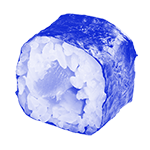
Suruga-cho Echogoya Nishiki-e
Concrete object, Advertising, National, Tokyo, Paris, Fashion, Culture, Economy, Lifestyle, Illustration
The history of advertising reflects social and economic change, technological progress and human endeavor through the decades. In Japan, the tradition of product advertising began in the Edo period, where merchants employed colorful and amusing storefront signs and euphoric sale pitches.
The Echigoya kimono store introduced revolutionary sales methods: from their cash sales at fixed prices, price tags and on-the-spot tailoring, to hikifuda flyers 1 and colorful nishiki-e woodprints. The store’s famous three beautiful women depict the latest fashion trends promoting their kimono designs, which fulfils a similar function to today’s fashion magazines. Nishiki-e was invented in the 1760s by printmaker Suzuki Harunobu, using the ukiyo-e technique. The print is created by carving a unique woodblock for each color, and using them in a stepwise fashion to allow many blocks of separate colors to fit together perfectly on the page, in order to create a single complete image.
Later, Kabuki theater –which in Kanji means sing (歌), dance (舞), and skill (伎) is a classical Japanese dance-drama where elaborate make-up is worn by its performers. It began featuring product placement and the formation of what we know as corporate tie ups today. These innovations form the roots of modern advertising, which in a larger scale, and deeply implanted in commercial practice, is visually part of our built environment.
The Ad Museum in Tokyo 2 exhibits a large documentation of flyers, pamphlets, magazines, newspapers, postcards, posters, banners, carved and painted wooden panels, paper lamps, storefronts, neon signs, led screens, billboards and super-billboards. In the streets of Paris and Tokyo, storefronts are displayed for pedestrians along the sidewalks while exterior lights, billboards and signs are embedded in the buildings. These dominate the cityscape’s scene and convey the goods and services offered both inside the building itself and elsewhere.
1. Decorative prints as pamphlets for advertisement from the Meiji period (1968-1911). Full-size sheets signed by known artists depict an evocative graphic, lavishly printed, that conveyed a feeling for the new and commercial exuberance, plus the name and location of a specific family business.
2. Opened in December 2002 by the Yoshida Hideo Memorial Foundation, it is the only museum in Japan dedicated to the promotion of studies in, and popular understanding of, advertising and marketing. https://www.admt.jp/en/
Concrete object, Advertising, National, Tokyo, Paris, Fashion, Culture, Economy, Lifestyle, Illustration
The history of advertising reflects social and economic change, technological progress and human endeavor through the decades. In Japan, the tradition of product advertising began in the Edo period, where merchants employed colorful and amusing storefront signs and euphoric sale pitches.
The Echigoya kimono store introduced revolutionary sales methods: from their cash sales at fixed prices, price tags and on-the-spot tailoring, to hikifuda flyers 1 and colorful nishiki-e woodprints. The store’s famous three beautiful women depict the latest fashion trends promoting their kimono designs, which fulfils a similar function to today’s fashion magazines. Nishiki-e was invented in the 1760s by printmaker Suzuki Harunobu, using the ukiyo-e technique. The print is created by carving a unique woodblock for each color, and using them in a stepwise fashion to allow many blocks of separate colors to fit together perfectly on the page, in order to create a single complete image.
Later, Kabuki theater –which in Kanji means sing (歌), dance (舞), and skill (伎) is a classical Japanese dance-drama where elaborate make-up is worn by its performers. It began featuring product placement and the formation of what we know as corporate tie ups today. These innovations form the roots of modern advertising, which in a larger scale, and deeply implanted in commercial practice, is visually part of our built environment.
The Ad Museum in Tokyo 2 exhibits a large documentation of flyers, pamphlets, magazines, newspapers, postcards, posters, banners, carved and painted wooden panels, paper lamps, storefronts, neon signs, led screens, billboards and super-billboards. In the streets of Paris and Tokyo, storefronts are displayed for pedestrians along the sidewalks while exterior lights, billboards and signs are embedded in the buildings. These dominate the cityscape’s scene and convey the goods and services offered both inside the building itself and elsewhere.
1. Decorative prints as pamphlets for advertisement from the Meiji period (1968-1911). Full-size sheets signed by known artists depict an evocative graphic, lavishly printed, that conveyed a feeling for the new and commercial exuberance, plus the name and location of a specific family business.
2. Opened in December 2002 by the Yoshida Hideo Memorial Foundation, it is the only museum in Japan dedicated to the promotion of studies in, and popular understanding of, advertising and marketing. https://www.admt.jp/en/


